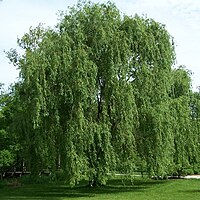
Photo from wikipedia
Salix L. (willow) is the largest genus of the family Salicaceae and plays an important role in riparian habitats, wetlands and in shrub tundra. Due to the different implications for… Click to show full abstract
Salix L. (willow) is the largest genus of the family Salicaceae and plays an important role in riparian habitats, wetlands and in shrub tundra. Due to the different implications for the species belonging to this family, it is fundamental to identify molecular tools characterizing relevant clones. A set of six multilocus and multiallelic simple sequence repeat (SSRs) markers are presented, leading to 390 polymorphic fragments considered as single dominant markers and able to discriminate successfully 92 S. alba L. from 24 Salix spp. The polymorphic fragments have been used to perform genetic diversity studies, and to investigate population structures and cluster analysis in a germplasm collection. The results highlight the capability of the six SSRs to be powerful genetic resources in applied forestry research, both to distinguish S. alba clones from Salix spp. and to perform genetic population studies for breeding programs.
Journal Title: Journal of Forestry Research
Year Published: 2019
Link to full text (if available)
Share on Social Media: Sign Up to like & get
recommendations!